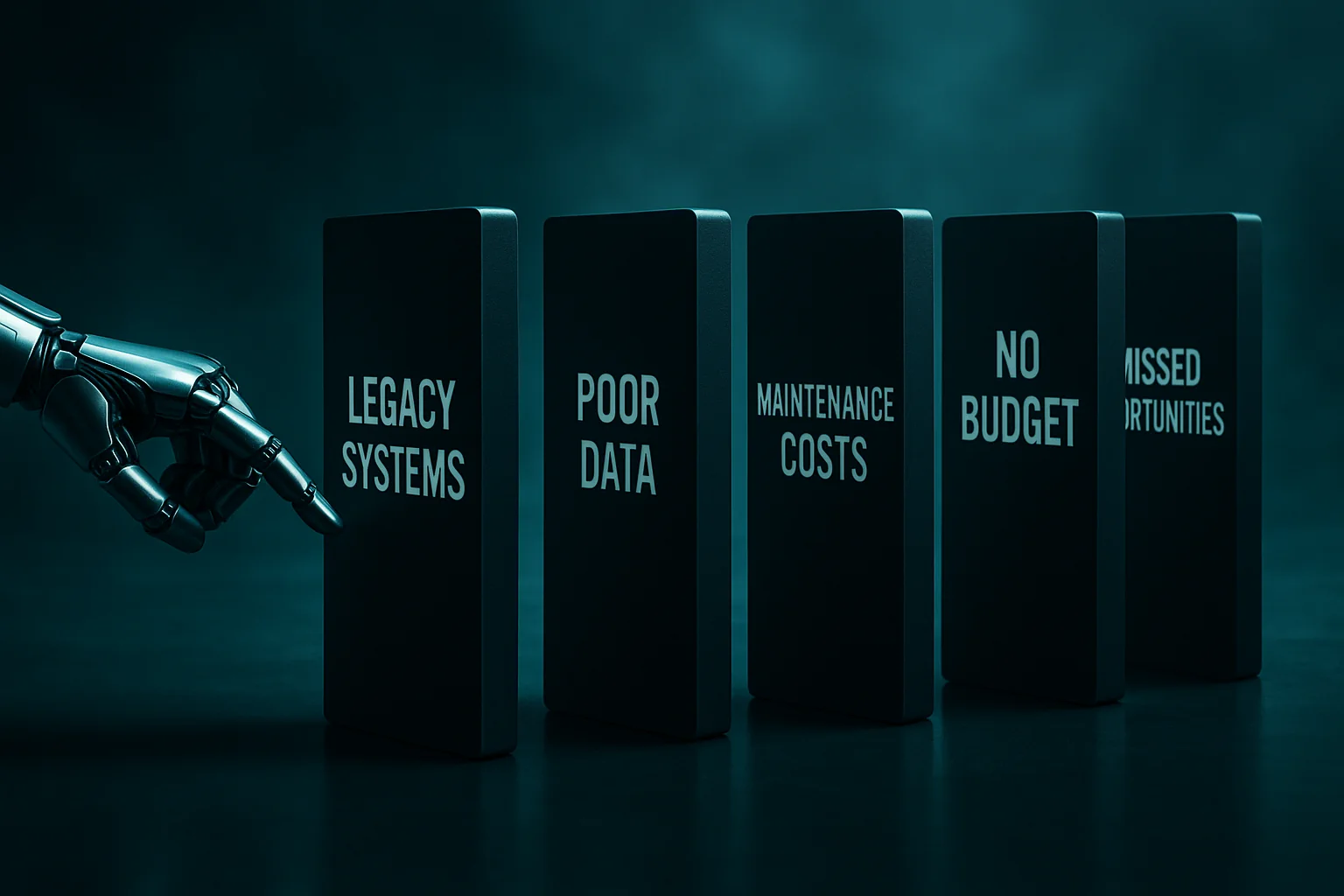Businesses and the public sector are increasingly looking to add AI into their systems and processes to accelerate work, cut costs, and remain competitive. For many, however, progress is blocked by a maze of aging systems, siloed and incomplete data, paper records, and outdated manual processes. To make matters worse, what qualifies as “outdated” is a moving target because of the pace of technological change.
What Is Getting in the Way?
Legacy infrastructure wasn’t always legacy. In its day, it may well have been cutting edge, but over time, an accumulation of supplemental systems and workarounds to paper over limitations has made it into a complex spider’s web requiring constant maintenance and support. These systems do what they were intended to do, but now, in a digital-first and increasingly AI-driven world, this approach is no longer sustainable. Here are some of the most common barriers to change.
- Old systems and software: Older systems may have been built using outdated programming languages, lack documentation, and run on closed, proprietary servers. Such systems require substantial maintenance to keep them running. A major roadblock is the absence of modern APIs in legacy systems. APIs are the bridges that enable systems to communicate; without them, connecting AI tools becomes exceptionally difficult.
- Disjointed data: Data in legacy systems might be stored in incompatible proprietary formats, in multiple silos that can’t talk to each other, or even locked in physical paperwork. This prevents AI or any other system from having a full, overarching view of the organisation’s data.
- Poor data quality: The most fundamental issue with legacy systems is frequently the poor quality of the data itself. It can be incomplete, inconsistent, or simply out of date. Due to the difficulty in adding new data fields to older systems, database fields may be repurposed and used in unexpected, undocumented ways with very little in the way of data integrity checking. Simply migrating this data to a newer platform will not resolve these issues; it could quite easily create problems.
- Manual processes: Workflows may still be reliant on emailing, printing, signing, approving, and filing. These processes only make sense in the context of a pyramid corporate structure with purely human workers and human bureaucracy. Digitising these chains of tasks can be very difficult, and such projects can easily end up automating the old inefficient processes, resulting in minimal benefits. Redesigning the data flows across the organisations is a major task and may require specialist help to handle this level of change.
- Workforce skills gap: Staff members working with legacy systems may not have the digital literacy or technical skills needed to adopt AI tools confidently. The technical staff may spend all their time maintaining the legacy infrastructure and need reskilling to work with new technologies. And leaders will need to adapt to a completely new landscape, both inside their organisation and to new competition from outside.
- Security and concerns: Legacy systems may lack modern security features such as multi-factor authentication or end-to-end encryption. Integrating AI with these vulnerable systems could expose sensitive data and create new lines of attack from hackers, potentially compromising both the AI and the legacy infrastructure.
The Domino Effect

These problems reinforce each other. Poor data leads to weak AI models. Integration failures undermine trust in new technologies. High maintenance costs for old systems eat up budgets that could be used to innovate. Limited time for staff retraining, or resistance to change further delays progress.
Legacy systems also tend to be brittle. Because they’re based on old code and complex interdependencies, even small changes can cause major disruptions. Organisations are understandably cautious about changing anything that might break their critical systems, and that caution can become paralysis.
All the while, as older organisations ponder how to update their older systems and migrate their data to modern formats, new companies that are not burdened by existing legacy systems will adopt new technologies from the beginning and gain an insurmountable lead.
In the public sector, this can lead to services being outsourced to more nimble external suppliers, and in the private sector, newer start-ups utilising the latest technology could put older, less agile companies out of business altogether.
Short-Term Fixes vs Long-Term Vision
When faced with the seemingly impossible task of re-engineering their entire legacy network of systems, organisations understandably look for workarounds. One common approach is to use APIs or middleware that sits on top of the legacy systems and acts as a bridge to AI or other modern tools. This approach can deliver quick wins such as chatbot assistants, recommendation engines, or dashboards pulling insights from legacy data.
This kind of solution is still constrained by the limits of the underlying legacy systems, however. Data remains hard to access, workflows are still clunky, and performance bottlenecks persist. Initial investment will be lower, but over time, the ongoing support of the legacy systems, combined with the middleware layer, is likely to overtake the initial savings and lead to a higher total cost of ownership.
At the other extreme, the entire system could be replaced in one fell swoop, moving to a scalable cloud infrastructure, modern architecture with interoperability and high security as standard, with native AI-ready APIs. This approach is inevitably more expensive, and implementation projects can run for years, bringing considerable operational risk. Migrating data alone can take months or even years, which means it is a moving target. While the implementation is ongoing, the legacy systems must still be maintained and supported.
There is also the risk that the implementation of a new system takes so long that the technological landscape has moved on by the time the project is completed. AI is currently evolving faster than organisations can construct a plan, never mind implement it.
A third option is to take a more gradual approach. With careful design, individual functions can be migrated to microservices and the cloud while remaining interoperable with older components. This can provide a lower-risk approach to upgrading the entire system, but it may take longer to get there.
Ultimately, the goal should not be to predict what an AI future will look like, but to develop modern, reliable, flexible systems that can adapt to whatever comes along without requiring an endless cycle of upgrading and reinvention.
| Feature | API/Connectors for Legacy Systems | Full System Replacement |
|---|---|---|
| Initial Cost | Lower to Moderate | High to Very High |
| Implementation Time | Shorter | Longer |
| Disruption to Operations | Lower (initially) | High during transition |
| Scalability | Limited by legacy system capabilities | High, designed for modern needs |
| Future-Proofing | Higher, modern architecture (but still subject to AI pace) | Low, tied to the aging core |
| Inherent Risk | Moderate to High (integration failure, limited AI efficacy) | High (project failure, cost overruns, adoption issues) |
| Data Modernization | Limited; data often remains in legacy formats/silos | Low, tied to aging core |
| Technical Debt Resolution | Low; often bypasses or adds to existing debt | High opportunity to standardize and govern data |
| AI Potential Unlocked | Full, optimized for AI capabilities | High potential to eliminate historical debt |
Sector-Specific Differences

Although organisations in the public and private sectors have similar problems with legacy systems, the reasons for change will be different. While the public sector will be more focused on upgrading public services or cutting costs to meet budget constraints, the private sector will be more focused on direct competitive pressures and the pursuit of market share.
Public Sector Hurdles
Government bodies generally carry a lot of historic baggage with them. Long-term outsourced IT contracts supporting a legacy of legislative changes across decades that are built into monolithic IT solutions. An often-overlooked factor is that incumbent government contractors may have financial incentives to maintain and extend the life of existing legacy systems rather than championing innovative AI solutions that could disrupt their established business models.
The UK government’s State of Digital Government Review 2025 estimates that 28% of central government systems can be classified as legacy:
State of digital government review – GOV.UK
Public sector procurement processes are often slow and bureaucratic, budgets are extremely limited and renewed annually, which makes investing in long-term modernisation programs difficult. The culture within many public sector organizations is inherently more risk-averse and resistant to sweeping changes than in more commercially driven private enterprises. Public bodies must navigate an exceptionally complex set of laws, policies, guidelines, and internal/external auditing regimes.
Attracting and retaining skilled AI professionals can be a major challenge due to rigid pay grading and lengthy hiring processes compared to the private sector. Those with specialist skills can command high salaries in the private sector, which may mean they are paid more than their managers in the public sector.
In the UK, there are some promising initiatives to roll out AI technology:
Archaic tech sees public sector miss £45 billion annual savings – GOV.UK
The Local Government Association in the UK maintains a case study bank showcasing diverse AI applications in local authorities, including some in health and social care. This offers a wealth of valuable insights and best practices for the use of AI in local government.
Artificial Intelligence Case Study Bank | Local Government Association
Private Sector Complexities
There is considerable variation across different sectors with each facing its own set of challenges.
Banking & Financial Services typically have a large, inflexible core system that handles high volumes of transactions, which can make deploying upgrades and new functionality extremely challenging. If anything were to go wrong then this could easily make news headlines and cause significant reputational harm. Modernization in this sector often involves progressive approaches, for example, a European bank integrated AI fraud detection with a legacy system via cloud services and APIs.
Manufacturing can depend on aging machinery with embedded systems and proprietary software. Common solutions generally consist of middleware and retrofitting machinery with sensors to provide real-time data. Pilot projects are often around predictive maintenance or quality control.
Other sectors face similar hurdles. Private Healthcare must balance AI integration with strict regulations and data confidentiality. Retail has to deal with integrating AI into point-of-sale and inventory systems while managing customer data privacy and training staff. Insurance is heavily regulated and dependencies on legacy systems commonly cause issues. Pharma is also heavily regulated, with additional care needed around research and development, which must be kept secure and not exposed by AI interfaces.
What Needs to Change?

Unlocking the potential of AI isn’t just a technological issue; it requires significant changes across people and processes too. Organisations must rethink how they manage their data while modernising infrastructure, processes, and upskilling their teams. Effective change management is critical.
Clean Up the Data
AI runs on data, but legacy environments often deliver a poor-quality supply of it. As highlighted earlier, data trapped in paper records, fragmented systems, or inconsistent formats cannot support reliable AI. The wealth of knowledge stored in the heads of employees should not be neglected either; it should be captured and stored or it will be lost when the employees leave the company, potentially taking their accumulated knowledge to a rival company.
The first step is to digitise, standardise, and govern. Leaders must treat data as an asset, with the same rigour applied to financial or legal resources. Establishing a coherent data strategy across the organisation will provide benefits with or without AI, such as improved consistency, integrity, availability, enhanced reporting, security, compliance, and overall business intelligence.
Data cleansing will require a significant effort, but historic data could be addressed on an incremental basis. Once this is in place, AI can be adopted much more easily.
Invest in People
Modern technology without modern skills is a recipe for failure. Organisations must assess existing skills in their workforce and determine where there are skills gaps. Ongoing programmes of digital literacy will need to be developed, this is not a one-off exercise. Using AI effectively also requires a change of mindset, asking questions rather than following predetermined administrative steps.
AI literacy should extend beyond IT teams to include HR, finance, operations, and leadership. In the public sector especially, new strategies are needed to attract and retain individuals with AI expertise, potentially involving more competitive compensation packages, streamlined hiring processes, and appealing programmes of career development and learning.
Teams are likely to be more cross-functional as information usage crosses traditional silo boundaries. Technical skills should not be the preserve of the IT department; team members require greater technical training to effectively use AI and related technologies.
Modernise Infrastructure
As discussed earlier, legacy infrastructure can be modernised using middleware and APIs, full system replacement, or a more progressive approach, replacing smaller self-contained functions with microservices and cloud-based systems.
The emphasis should be on flexibility, building systems that can evolve with future AI developments rather than locking into a narrow solution that may soon become outdated.
Start Small but Smart
Focused pilot projects can lower the barriers to adopting AI. The goal is not just to prove AI works, but to identify issues around integration with other systems, the needs of stakeholders, data quality, and effective change management.
Pilots should start small with well-defined projects as a proof-of-concept. The intention is to demonstrate the value of AI in a controlled environment, allowing risks to be managed. Valuable lessons can be learned from pilot programmes which can then inform future rollouts, and build internal support and momentum.
Plan for the Long Haul
Short-term wins are important, but they must feed into a longer-term roadmap. Without a strategic plan, organisations risk a proliferation of disconnected AI tools that add complexity rather than clarity.
A robust roadmap should align AI initiatives with organisational goals, set realistic timelines, and include plans for ongoing learning and adjustment. The longer that legacy systems persist, the more expensive and painful the eventual transition becomes. Leaders must weigh the hidden costs of inertia against the visible costs of change.
Embed Ethics and Trust
AI can introduce new risks, from biased algorithms to opaque decision-making. Public trust in AI is fragile, especially when sensitive data is involved, so governance frameworks must be built in from the start, not bolted on later.
This means auditing data for bias, making AI decisions explainable, securing personal and confidential data, and setting clear lines of accountability. Regulatory compliance is the baseline, not the ceiling. Organisations must go further; transparency, fairness, and inclusivity must be designed into every AI initiative if adoption is to be sustainable.
In short, preparing for AI requires systemic change. The foundational work, data cleanup, workforce transformation, technical renewal, careful piloting, and ethical foresight are not optional; it is the groundwork on which future success is built.
Final Thought
The journey to successful AI adoption is complex for both public sector bodies and private companies. Legacy systems, incompatible data formats, paper-based records, and skill gaps present significant barriers that require more than just technological fixes.
Modernisation is a strategic issue, not just a technical one. It touches on finance, leadership, workforce planning, risk management, and customer experience. Organisations that embrace the challenge will be better equipped not only to deploy AI but to compete in a digital-first world.
Adopting AI is not a sprint but a sustained marathon. It demands strong leadership, strategic foresight, a willingness to adapt, and a commitment to continuous learning. By embracing these principles, both public and private sector organizations can realise the benefits of AI technologies.
The question isn’t whether to modernise. It’s how soon you’ll start and how smartly you’ll go about it. Is your organisation still stuck in maintenance mode, or are you ready to build for the future?

